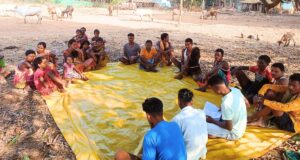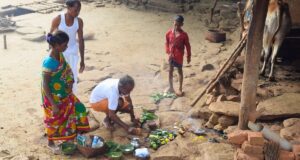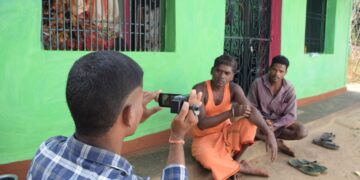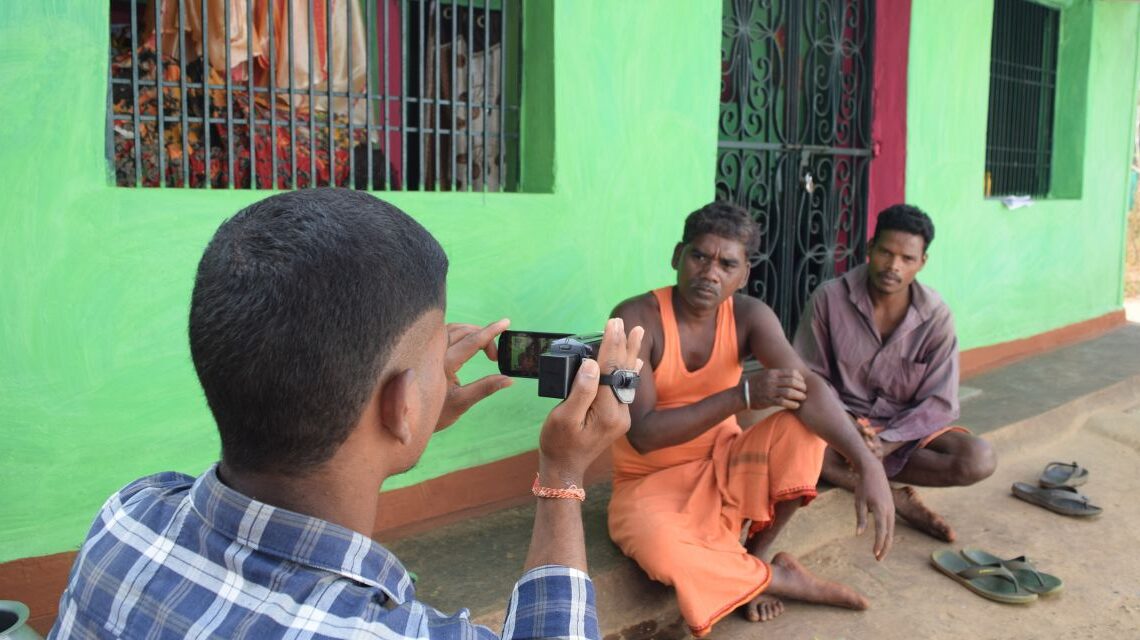ABHIJIT MOHANTY
Malkangiri, Odisha: With its lush green trees, gurgling streams and clear waters, Kudhariphasa in Paikmal block of Bargarh stands humble against the imposing background of the majestic Gandhamardan hills. A winding road takes one to the village that got its name from a story of the yesteryears.

“In Odia, kuradhi means axe. Once a man was cutting a tree when a forest watchman caught him off guard. The frightened man could do nothing but run away. Unfortunately, the partially cut tree fell on the watchman, who died instantly. Some people said he killed the watchman, some others said the phasha [net] he had spread out proved fatal. That was how our village name, Kudhariphasa, came about,” Madhusudan Mallik, a local, tells Taruni Mallik and Mina Mallik.
Taruni (15), a class 10 student at Kudhariphasa, and Mina (17), a class 10 passout, were documenting their village history under a programme funded by the the Department of Agriculture and Farmers’ Empowerment, under its flagship Odisha Millets Mission (OMM) scheme. To preserve village histories, OMM has taken the participatory route of holding discussions and interviews with elderly people, so that future generations can uphold and carry on their rich cultural heritage.

When Taruni and Mina started exploring their roots by talking to elders, they learnt among other things how their elders had to relocate due to a dam construction. “Our village existed much before Manbhang Dam was constructed in 1982. The village then was called Mandia grama. When the dam came up, people were forced to leave the village. Some moved to Kudhariphasa, some to Laudmal,” says Padmani Mallik, another village elder.
So far, around 30 students of classes 7 to 10 from the tribal villages in Bargarh, Angul and Malkangiri districts have been trained at the district level to conduct interviews and ensure written and video documentation of their village histories under the pilot programme named ‘Engaging Schoolchildren for Documentation of Agrobiodiversity, Cropping Systems and Food Culture’.
From the 15 selected villages in each pilot district, two students each were engaged for the documentation work. Those interested in documenting their own village’s history and familiar with mobile videography were selected. Thematic experts educated them about the technical nitty-gritty of the shoot. The production was costless as the students used mobile phones to capture the nuances of the village life. The raw videos they fetched were compiled and edited by thematic experts.
Experts in social science designed the interview questions and a booklet for students for documentation, which were disseminated through workshops and seminars at the district level. There are plans to share the booklets with the district administration, agriculture department and other relevant departments in future for developing villages and introducing necessary welfare schemes.
“At school, we study about our country and its different states. But we know very little about our village and its history,” says Babula Golari (16), a class 10 student, who has interviewed elderly residents of Baliguda in Chitrakonda block of Malkangiri under the OMM programme.
Also Read- Ex-Jharkhand MLA, extremist get life imprisonment in double murder case
Apriankita Barik (13), a student from Kishorenagar block, never knew the reason why her village was named Himirita. “When I enquired with the village elders, they told me that cold conditions prevailed in our village in the past. Hima means cold in Odia, and that was how our village got its name,’’ she says.
The learnings were not only about the origins of village names, but also about traditional farming practices, food habits and village culture, all of which have been disappearing due to modernisation. “During the village meetings and interviews we get a feel of our shared history… When we recorded the experiences of our elders, we also realised the value of keeping these stories alive,” says Taruni.

Changing food habits
According to village elders, collection of forest produce such as honey, tubers, roots, fruits, berries, mushrooms, greens and subsistence agriculture were the mainstay in Kudhariphasa at one time. From five to seven households, the village has grown to house 80 households.
One of the major findings from the interviews was the loss of traditional agricultural practices and crops in village areas. ‘’When I was a child, my father used to grow around 32 varieties of crops under a mixed system of farming,’’ says Madan Pangi (74) of Gunthaguda in Chitrakonda. Traditional crops such as millets, pulses, cereals, tubers and roots were our major staple foods. However, farmers nowadays have replaced these crops with paddy, cotton and potatoes, he adds.
According to Madan, many traditional seed varieties that needed less inputs and could withstand erratic rainfall were lost around 20 years ago as people stopped cultivating them. They hardly fetched good market prices. Penetration of hybrid seeds and commercial crops fast-tracked their extinction.
“My father died when I was around 30. He was among the few farmers in our village who preserved traditional varieties of finger millet, arhar [pigeon pea] and paddy. I continue to grow these varieties in my farm for household consumption. These seed varieties are not available in the market. If we do not preserve them, we may lose them forever,’’ explains Madan.
Class 10 student Trinath Pangi (16), who interviewed Madan, says he was surprised “to know that our grandparents cultivated such a wide range of crops”. “There were traditional recipes, which were lost when people stopped farming those crops and switched to monocropping,” he shares.
Little millet porridge was once a delicacy among the tribals in Chitrakonda block. Over the years, the cultivated area under little millet fell substantially as these crops were not remunerative for farmers. Similarly, Kodo millet rice was once widely consumed by tribals of the Paikmal block. But with the easy availability of rice under the public distribution system, the demand for Kodo millet went down.
‘’We are what we eat,’’ Lachma Pangi (67) of Gunthaguda tells 101Reporters. “Our traditional recipes were passed on from generation to generation. They nourished our body and provided the necessary strength to work in this hilly terrain. However, the younger generation is not interested in consuming them. In fact, they are more attracted towards urban food like chow mein, roll and fried items.’’
However, after documenting village history, students have shown keen interest in recording traditional recipes. “Earlier, people used to prepare a certain pickle from mahua flowers. I have started documenting this traditional recipe. Also, I am interested in documenting the traditional recipe of bamboo shoot curry and fried chips,” says Trinath.
Babula, meanwhile, is determined to conserve and promote traditional crops. “Climate is changing. Sometimes it rains early and at other times, it gets delayed. Our traditional crops such as millets can sustain such extreme conditions. I will encourage young farmers to bring back our traditional crops to the farm.”

Dying village culture
Parvati Mallick (60) of Taladar village in Kishorenagar block of Angul recalls the traditional process of marriage. “In the past, weddings were simple. People used to hire a dhulia [traditional drummer] and nachunia [dancer]. They performed in a procession and the bride travelled in a bullock cart. Now people use DJ music, and vehicles that we have never seen in our times,” she says.
Mostly, sal leaf cutlery were used during weddings and community feasts in Malkangiri. Plastic plates and bowls have replaced the biodegradable cutlery these days. The changed practices have reduced the income of villagers, who could once have sustained themselves by stitching sal leaf plates and bowls.
Danda jatra is one of the oldest festivals in Himirita. Hymns of the goddess and prayers for bumper harvest are all part of the many songs the group of devotees sung during the procession. However, the students recording village history have found that many villages in Himirita’s neighbourhood have stopped celebrating the jatra.
Student learnings
“I never did video documentation before,’’ says Sangita Mahanand (15), a class 10 student at Parashkandi in Paikmal block of Bargarh district. “Today, I feel happy and proud that I have done a video documentation of our village history. Now, others can know more about our village.”
“The documentation work was fun and enriching for us,” Sibasankar Gudia (12), a class 8 student from Chitrakonda block. ‘’It is not like reading a book and answering the questions. It is like going to the past and learning about the changes that have taken place in our village over the years.’’
Jaganath Sahoo (16), a class 10 passout from Kasturibahal village in Kishorenagar block says, “In my childhood, I heard a lot of folk tales and stories from my grandparents. Nevertheless, while interviewing the village elders, I came to know that they know the past of the village like no one else does. If we do not document their stories and experiences, we may lose the rich history and culture of our village.’’
Also Read- Jharkhand News: Three women killed, four injured while digging soil in Baharagora
“Village history is important because it has a significant impact on our everyday life, developing practices, behaviours and culture. The youth, especially the students, have made it their mission. It has also created connections, bridging the gap between the old and young in villages,” Chudamani Barik, Block Education Officer, Paikmal, tells 101Reporters.
“Written documents about the village’s past are scanty,’’ says Swayamprava Parhi, who has worked with the students to design the interview booklet. This historical information is passed on from generations mainly through stories, songs and folk tales. The community’s elderly inhabitants exist as living archives, having important historical information and recollections, she says.
For the first time, several school students have become documentary makers, and this has definitely changed their approach towards all things local. They have understood the need to preserve their culture and food habits, what needs to be seen now is how they will manage to do it in the long run.
(Abhijit Mohanty is a Odisha-based freelance journalist and a member of 101Reporters, a pan-India network of grassroots reporters.)











